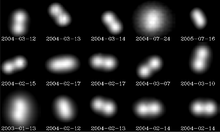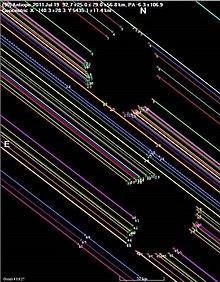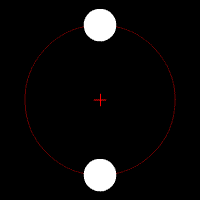(90) Antiope
|
Asteroid (90) Antiope |
|
|---|---|
| Properties of the orbit ( animation ) | |
| Orbit type | Outer main belt |
| Asteroid family | Themis family |
| Major semi-axis | 3.1501 AU |
| eccentricity | 0.1657 |
| Perihelion - aphelion | 2.6283 AU - 3.6719 AU |
| Inclination of the orbit plane | 2.207 ° |
| Length of the ascending node | 69.971 ° |
| Argument of the periapsis | 244.884 ° |
| Time of passage of the perihelion | 23rd January 2017 |
| Sidereal period | 5 a 217 d |
| Mean orbital velocity | 0.0185 km / s |
| Physical Properties | |
| Medium diameter | 87.8 ± 1 km |
| Dimensions | 93.0 × 87.0 × 83.6 km |
| Dimensions | 4.2 x 10 17 kg |
| Albedo | 0.058 ± 0.004 |
| Medium density | 1.25 ± 0.05 g / cm³ |
| Rotation period | 16 h 30 min |
| Absolute brightness | 8.27 likes |
| Spectral class | C. |
| history | |
| Explorer | Karl T. R. Luther |
| Date of discovery | October 1, 1866 |
| Another name | 1952 BK 2 |
| Source: Unless otherwise stated, the data comes from JPL Small-Body Database Browser . The affiliation to an asteroid family is automatically determined from the AstDyS-2 database . Please also note the note on asteroid items. | |
(90) Antiope is an asteroid located in the main outer asteroid belt . Due to the discovery of the slightly smaller companion S / 2000 (90) 1 , Antiope is considered a double asteroid system.
Discovery and naming
Antiope was discovered on October 1, 1866 by the German astronomer Karl Theodor Robert Luther at the Düsseldorf observatory .
The celestial body was named after Antiope from Greek mythology , but it is controversial whether after the Amazon Antiope , the daughter of Zeus , who was kidnapped by Theseus , or after Antiope , the lover of Zeus, to whom she had two sons, Zethos and Amphion gave birth.
Since the companion's discovery, the name “Antiope” has officially been used for the larger component, while the designation S / 2000 (90) 1 applies to the smaller component . But the name is often used for the whole system. Unofficially, the asteroid is therefore sometimes referred to as "Antiope A" .
In total, the asteroid has been observed by several earth-based telescopes, so far a total of 3212 times within 150 years. (As of Sept. 2017).
Track properties
Orbit
Antiope orbits the Sun in a prograde elliptical orbit between 393,182,000 km (2.63 AU ) and 549,308,000 km (3.67 AU) from its center. The orbital eccentricity is 0.166, the web is about 2.2 ° relative to the ecliptic inclined . Its orbit is therefore in the outer asteroid belt .
The orbit period of Antiope is 5.59 years.
Antiope belongs to the Themis family , a group of almost 5,000 asteroids that orbit the sun in similar orbits and are likely fragments of a previous collision.
rotation

Antiope rotates around its axis once every 16 hours and 30 minutes. Since the orbit time is the same as the rotation time, and the smaller component S / 2000 (90) 1 behaves in the same way, it is a doubly bound rotation . This means that both bodies always face the same side. According to the Pluto / Charon system , a double-bound rotation was detected here for the second time. This requires similar masses and a narrow orbit of the two bodies.
From this it follows that the asteroid performs 2,968.7 self- rotations ("days") in one Antiope year .
Observations of the light curve show an alignment of Antiopes Pol in the direction of the ecliptic coordinates with 2 ° uncertainty. This results in an axis inclination of 63.7 ± 2 °. Antiopes rotation is therefore prograd .
Physical Properties
size
The previous observations by Antiope indicate a rounded, slightly irregularly shaped body; the most precise determination of the diameter ( geometric mean ) is 87.8 km. With regard to the exact dimensions, the most precise value is 93.0 × 87.0 × 83.6 km. The measured value of around 116 km relates to both Antiope bodies.
Based on an average diameter of 87.8 km, the surface area is around 24,200 km², which is just about the size of Macedonia .
Overall, both Antiope components are among the 500 largest asteroids in the solar system.
| year | Dimensions in km | source |
|---|---|---|
| 2001 | 120.07 ± 4.0 | IRAS |
| 2007 | 87.8 ± 1 | Descamps et al |
| 2007 | 93.0 x 87.0 x 83.6 | Descamps et al |
| 2014 | 115.974 | Masiero et al |
The most precise determination is marked in bold .
surface

In 2007, observations with the VLT telescope using adaptive optics and analysis of light curves provided evidence of a 68 km impact crater on one of the two bodies. This could be the result of a proto-antiope collision that split the body into two bodies of similar size. Such an impactor would have to have been more than 17 km in diameter. The crater can not be resolved by the 10 m Keck Telescope II , but it was confirmed by the approximately 30 second occultation of the star LQ Aquarii on July 19, 2011. Star occultation was recorded as early as June 11, 1980.
internal structure
Antiope is one of the C-type asteroids and therefore has a dark, carbon-rich surface with an albedo of 0.058. The surface color is therefore darker than coal. The unusually low mean density of 1.25 g / cm³ is an indication that it is not a compact body, but rather a rubble pile , an accumulation of dust and rocks that is interspersed with cavities. The porosity is estimated to be over 30%. It is conceivable that the asteroid formed from rubble from a previous collision, possibly the one that gave rise to the Themis family.
According to a spectroscopic examination carried out in 2009, the structure of (90) Antiope and S / 2000 (90) 1 is identical.
So far, the mass of Antiope could be calculated on.
The absolute brightness is given as 8.27 mag.
The mean surface temperature is around 158 K (−115 ° C) and can rise to a maximum of 244 K (−29 ° C) at noon.
Double system
Due to the discovery of the companion in 2000, Antiope consists of two large bodies that revolve around each other at an average distance of 170 kilometers in 16.52 hours , which means that both bodies always face the same side. Such binary systems are rather a rarity in the main belt, while they are not uncommon in the Kuiper belt . The total mass of the system is
| Components | Physical parameters | Path parameters | discovery | |||||
|---|---|---|---|---|---|---|---|---|
| Surname | Throughput diameter (km) |
Relative size % |
Mass (kg) |
Major semi-axis (km) |
Orbital time (d) |
eccentricity |
Inclination to the ecliptic |
Date of discovery Date of publication |
|
(90) Antiope ("Antiope A") |
87.8 | 100.00 | 4.2 · 10 17 | ~ 85 | 0.6878 | <0.006 | 63.7 ° | October 1, 1866 1866 |
|
S / 2000 (90) 1 ("Antiope B") |
83.8 | 95.4 | 4.1 · 10 17 | ~ 85 | 0.6878 | <0.006 | 63.7 ° | August 10, 2000 October 3, 2000
|
See also
Web links
- Wm. Robert Johnston: (90) Antiope and S / 2000 (90) 1. (English).
- Franck Marchis: 90 Antiope A & B. ( Memento from August 28, 2008 in the Internet Archive ). (English).
- William J. Merline: 90 Antiope: Raw Keck Image. Raw image from Antiope (VLT telescope, English).
- 90 Antiope. ( Memento of March 8, 2008 in the Internet Archive ). March 15, 2002, accessed November 30, 2009.
Individual evidence
- ^ Discovery Circumstances: Numbered Minor Planets. The international Astronomical Union - Minor Planet Center, accessed August 7, 2020 .
- ↑ (90) Antiope in the Small-Body Database of the Jet Propulsion Laboratory (English).
- ↑ D. Nesvorny, M. Broz, V. Carruba Identification and Dynamical Properties of Asteroid Families , 2014, arXiv: 1502.01628
- ↑ Stuart J. Weidenschilling et al .: Origin of the double asteroid 90 Antiope: a continuing puzzle (2001) (PDF). (PDF) Retrieved September 6, 2017 .
- ↑ IRAS (2016): Binary Asteroid 90 Antiope Closest Approach To Earth (1,773 AU). Archived from the original on September 6, 2017 ; accessed on September 6, 2017 .
- ↑ Pascal Descamps et al: Figure of the double Asteroid 90 Antiope from adaptive optics and lightcurve observations (2007). Retrieved September 6, 2017 .
- ↑ Pascal Descamps et al: The Impossible Siblings (2007). (No longer available online.) Archived from the original on April 3, 2007 ; accessed on September 6, 2017 .
- ^ Joseph R. Masiero et al.: Main-belt Asteroids with WISE / NEOWISE: Near-infrared Albedos . 2014, bibcode : 2014ApJ ... 791..121M .
- ^ Franck Marchis et al: An Occultation by the double asteroid (90) Antiope seen in California (2011). Retrieved September 6, 2017 .
- ↑ Franck Marchis, J. Emilio Enriquez, Joshua P. Emery, Jerome Berthier, Pascal Descamp, Frederic Vachier, The Origin of (90) Antiope from Component-Resolved Near-Infrared Spectroscopy , Icarus 213 (1): 252-264, 2011 , arXiv: 1102.3458



